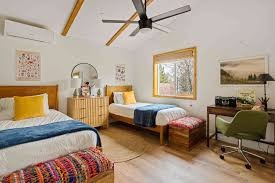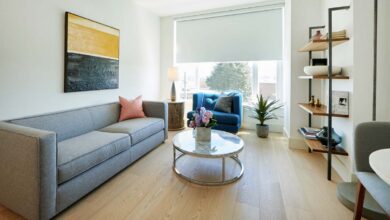10 Clever Bedroom Ideas for Siblings Who Share a Room

Sharing a bedroom can be one of childhood’s greatest adventures or its biggest challenge, depending on how the space is designed. When siblings occupy the same room, parents face the unique task of creating an environment that honors each child’s individuality while fostering harmony and cooperation. The right approach transforms a potentially cramped situation into an opportunity for creativity, connection, and personal growth.
Whether you’re working with a spacious area or a compact corner, these ten clever ideas will help you design a shared bedroom that works beautifully for both children.
1. Define Personal Zones with Creative Dividers
Creating a sense of individual territory is crucial when siblings share quarters. Visual dividers help establish boundaries without requiring permanent walls or major construction. Bookshelf units positioned perpendicular to the wall create natural partitions while providing valuable storage. Floor-to-ceiling curtains on ceiling tracks offer flexibility, allowing kids to open their space for play or close it for privacy.
Other families use hanging beads, decorative screens, or even suspended fabric panels that add artistic flair while marking personal areas. One particularly inventive solution involves painting or wallpapering each half of the room in coordinating but distinct styles, giving each child ownership over their designated zone.
The key is making these divisions feel intentional rather than restrictive. When children understand where their personal space begins and ends, conflicts decrease significantly. They learn to respect boundaries while still enjoying the benefits of companionship.
2. Embrace Vertical Sleeping Solutions
When floor space is limited, thinking vertically opens up remarkable possibilities. Stacked sleeping arrangements immediately free up square footage for other essential activities. This approach works particularly well in rooms where two separate beds would leave barely enough room to walk between them.
Beyond the traditional stacked configuration, consider L-shaped arrangements that tuck into corners, or perpendicular setups that create interesting architectural elements. A high sleeper bed elevates the mattress significantly, creating an entire usable zone underneath perfect for desks, cozy reading nooks, or additional storage cabinets. This design essentially gives you two functional levels in the space of one.
For families with three children in one room, a triple bunk bed accommodates everyone without overwhelming the space. The vertical approach not only solves practical problems but often becomes a favorite feature that kids proudly show visiting friends.
3. Color Code for Organization and Identity
Assigning each child a signature color creates an organizational system that even young children can easily follow. This strategy extends far beyond simple decoration. Towel hooks, storage bins, drawer labels, bedding, and desk accessories in designated colors eliminate confusion about ownership.
Choose colors that complement each other to maintain visual cohesiveness. Teal and coral, navy and gold, or sage green and dusty rose create sophisticated pairings that grow with your children. The color coding reduces daily friction over whose items belong to whom while allowing each child to express their personality within the shared environment.
This system also makes cleanup more manageable. When everything has a color-coded home, putting things away becomes straightforward rather than frustrating.
4. Install Individual Task Lighting
Nothing sparks sibling conflict quite like mismatched sleep schedules or study habits. One child wants to read while the other needs darkness to sleep. Individual lighting solutions resolve this common challenge beautifully.
Clip-on reading lights, adjustable wall sconces positioned beside each sleeping area, or LED strips with independent controls give each child autonomy over their personal lighting. This independence proves especially valuable as children age and their schedules naturally diverge.
Consider lights with dimming capabilities or warm color temperatures that promote relaxation. Smart bulbs controllable via app allow older children to adjust their lighting without getting out of bed, reducing disturbances to their sibling.
5. Create a Shared Creative Wall
While personal space matters tremendously, incorporating elements that encourage collaboration strengthens sibling bonds. A shared creative wall becomes a joint project that both children contribute to equally. Large chalkboard paint sections, magnetic boards, or cork bulletin boards invite ongoing artistic expression.
This communal area might display collaborative artwork, a shared collection, family photos both kids helped select, or a vision board they create together. Some families designate this space for a growth chart marking both children’s heights, creating a visual representation of growing up together.
The shared wall serves as a reminder that while they each have individual needs, they’re also part of a team navigating childhood side by side.
6. Maximize Under-Bed Storage Potential
Every piece of furniture should work overtime in a shared bedroom. The space beneath sleeping surfaces often goes underutilized despite offering significant storage capacity. Rolling bins, drawer systems, or custom-built platforms with built-in storage transform this dead space into valuable real estate.
Store out-of-season clothing, extra bedding, toys rotated out of active play, or sports equipment in these hidden compartments. Labeled containers make retrieval easy while keeping the room visually uncluttered. For beds without clearance underneath, consider raising them on bed risers to create storage space where none existed before.
This hidden storage approach keeps the room feeling open and organized while ensuring everything has a designated home.
7. Incorporate Multi-Functional Furniture
Furniture that serves multiple purposes earns its place in shared spaces. Ottomans with internal storage provide seating and toy organization. Desks with hutches offer study surfaces and display areas. Daybeds function as seating during play and sleeping at night.
Murphy beds or wall beds represent the ultimate multi-functional solution for older children, folding up to reveal open floor space during waking hours. Loft configurations with desks, seating, or play areas underneath combine sleeping and activity zones in one footprint.
When selecting furniture, always ask what secondary function each piece might serve. This mindset leads to creative solutions that make small spaces work harder.
8. Establish Individual Display Areas
Every child needs space to showcase achievements, collections, and treasures that define their current interests. Designating individual display shelves, shadow boxes, or wall-mounted ledges gives each sibling a personal gallery.
These display zones might house sports trophies, rock collections, favorite books, art projects, or beloved toys. The specific contents matter less than the child’s control over their personal showcase. Knowing they have a dedicated spot to celebrate what matters to them fosters pride and self-expression.
Rotate displayed items periodically to keep the space fresh and reflect evolving interests. This practice also teaches valuable decision-making skills as children choose which items deserve prominent placement.
9. Design Coordinated but Distinct Bedding
Bedding offers an excellent opportunity to honor individuality within a cohesive design scheme. Rather than identical sets that erase personality, choose coordinated patterns or colors that complement each other while remaining distinct.
One child might have striped sheets while the other has polka dots, both in the same color family. Or select bedding that shares a theme, like woodland animals or space exploration, but features different specific designs. Allowing children to help select their bedding within agreed parameters gives them ownership over their personal space.
Quality bedding also contributes significantly to sleep quality, which becomes especially important when children share sleeping quarters. Comfortable, appealing bedding makes bedtime more inviting for everyone.
10. Install a Homework Command Center
As children grow, homework and school projects become daily realities. A centralized homework command center equipped with necessary supplies serves both siblings efficiently. Position desks side by side or in an L-configuration to create companionable study space.
Include shared supplies in central organizers: pencils, markers, paper, scissors, and glue accessible to both children. Individual desk lamps, chair cushions in each child’s designated color, and personal drawer units maintain that crucial sense of ownership within the shared workspace.
A large wall calendar or planning board helps siblings coordinate project timelines and avoid last-minute supply scrambles. This organized approach to schoolwork reduces stress for both children and parents while teaching valuable time management skills.
Bringing It All Together
Designing a shared bedroom that truly works requires balancing competing needs: personal space with shared experiences, individual expression with cohesive design, current requirements with future flexibility. The most successful shared bedrooms achieve this balance through thoughtful planning and ongoing adjustments as children grow.
Involve your children in the design process whenever possible. Their input ensures the space reflects their needs and preferences, increasing their investment in maintaining it. Start with one or two ideas from this list rather than attempting a complete overhaul simultaneously. Small changes often yield significant improvements in how siblings interact within their shared space.
Remember that sharing a bedroom teaches invaluable life skills: negotiation, compromise, respect for others’ belongings, and consideration for different needs and schedules. These lessons extend far beyond childhood, shaping how your children navigate relationships throughout their lives.
The goal isn’t creating a perfect showroom but rather a functional, nurturing environment where siblings can grow, play, argue, make up, and build memories together. When designed with care and creativity, a shared bedroom becomes not just a place to sleep but a foundation for lifelong sibling bonds.



